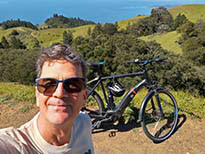* * *
I heard a weird noise when I got out of my car in the Sunset Point parking area. I thought the radiator fan might still be running, but that didn't check out. Then I thought there was a huge bee's nest in the ground in front of the car, but that didn't pan out either. I finally looked up in the sky and there it was, a drone. I can only hope it's not the beginning of a trend up there.
Before heading up the mountain I made a quick check at Redwood Creek down near Muir Woods. The water's probably still too low to entice any salmon upstream.
I read another interesting book over the last couple of days, called Integral Psychology by Ken Wilber. I like his idea of nesting stages of growth for human consciousness, where each successive stage integrates a broader, deeper, more conscious outlook on the world. Unfortunately, like a flower that doesn't quite unfurl properly, a person's consciousness can also hit roadblocks and dissociate instead of integrate, and thereby leave some aspect of potential growth behind.
Childhood dissociations are probably fairly common and can lead to lifelong debilities and constrictions of one's true nature. The good news is those dissociated aspects can be retrieved and integrated in adulthood, even as new growth stages continue to unfold throughout one's life, offering opportunities for renewal even in old age.
So here's to getting older and expanding my consciousness, not my waistband.
I could probably have spent the whole morning doing photography in one small area. There were so many mushrooms popping up that the composition possibilities were endless.
I wondered if this fly was feeding on the spores inside the puffball since the hole that opens up to release spores is right about where the fly is.
But I think the fly was just perched, not feeding.
I ended up hiking a short loop off the Cataract Trail, following a deer trail uphill and into more woods.
It didn't rain at all, but it was quite drippy under the forest canopy, though not so bad that I needed my umbrella. I just had to be careful not to get drops on the lens.
I headed out to a magical Bolinas Ridge vista point just to take it in, then had to jog back to the car to get my camera. I don't think I'd been out that way in a long time. It was good to see a little bit of green grass starting to come in.
Out near Druid Rocks I got to thinking about Wilber's model of integral psychology and wondered if reconnecting with and integrating the lost parts of one's true nature and continuing to open up to new layers of consciousness might be reflected in someone's art. You probably can't separate the two, since you'd be growing as an artist right along with other aspects of your life. I guess we just have to keep all the channels open and the energy flowing, and see what happens.
* * *











































